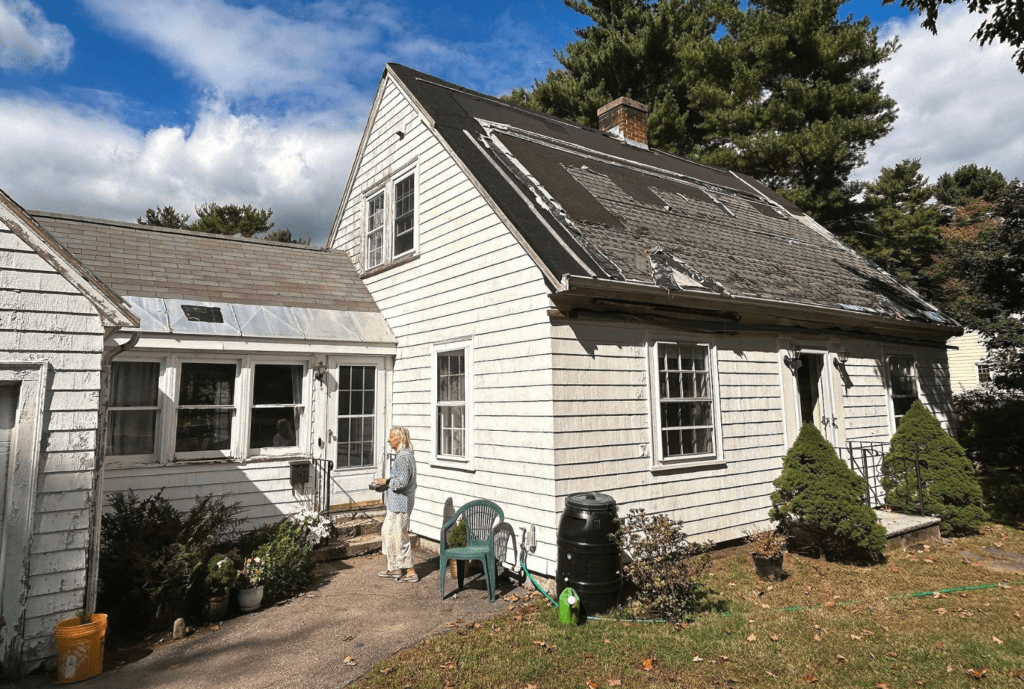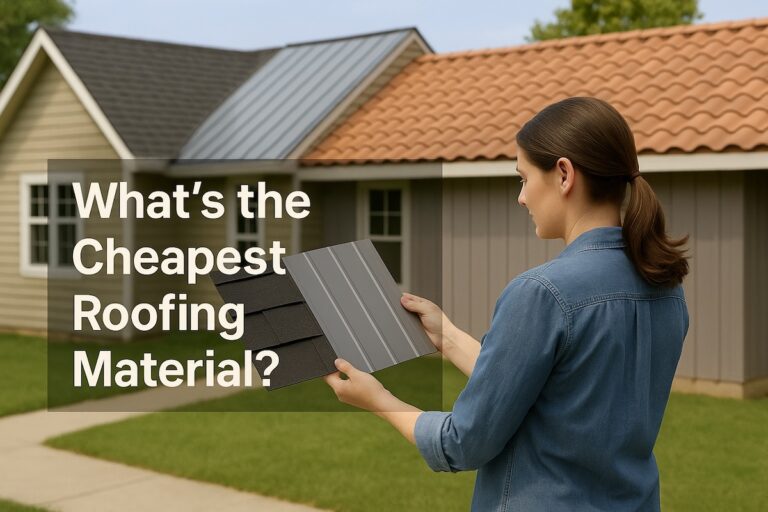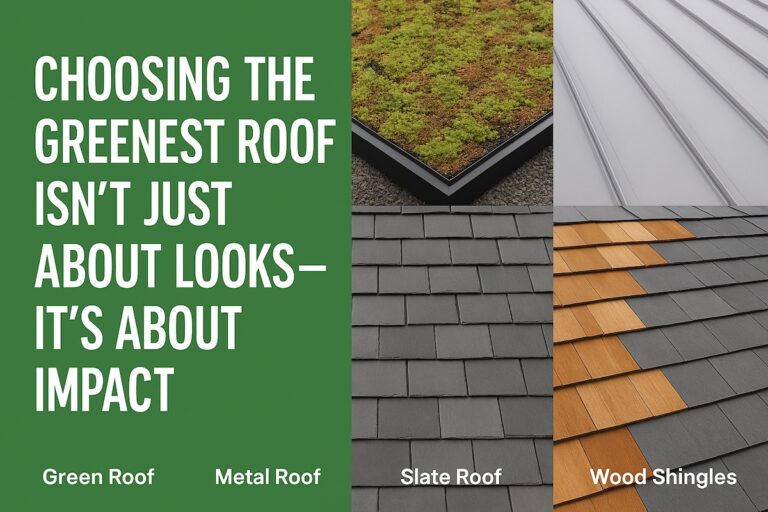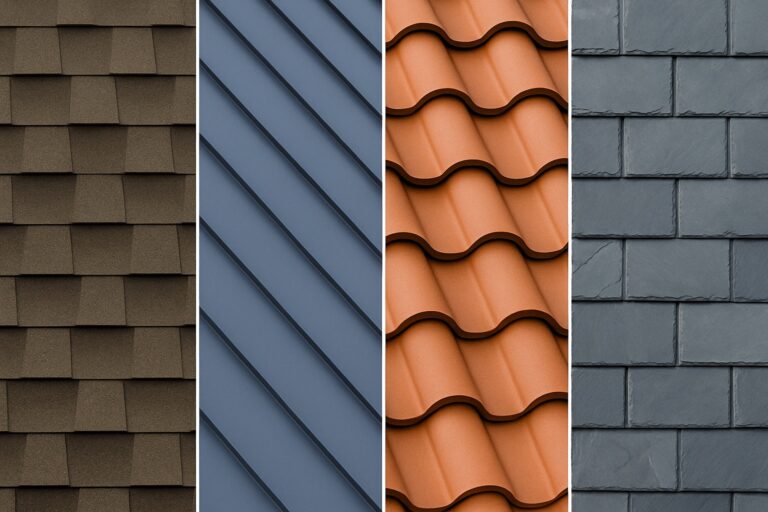-
Steel is the best all-around performer – Affordable, durable, and widely available in standing seam and stone-coated options.
-
Aluminum resists corrosion – Ideal for coastal homes but more prone to dents in hail-prone regions.
-
Copper is a luxury pick – Stunning and long-lasting, but comes with a premium price tag.
-
Zinc is self-healing and eco-friendly – Great for sustainability-minded homeowners.
-
Metal shingles offer the best of both worlds – Traditional looks with modern metal performance.
-
Profile matters just as much as material – Standing seam offers top weather protection, while shingles and corrugated styles cater to aesthetic preference.
-
Installation quality makes or breaks your investment – Always work with a certified, experienced contractor.
👉 Ready to see how each metal roof would look on your home? Try our interactive roof designer tool to visualize your options in real time.
Introduction
Metal roofing has rapidly become the preferred roof material for homeowners seeking durability, energy efficiency, and long-term value. Whether you’re replacing an aging asphalt shingle roof or planning your forever home, choosing the right metal roof material is more important than ever. But not all metals are created equal—each type of metal offers distinct advantages depending on your climate, budget, and design goals. This guide breaks down the most popular metal roof options so you can make a confident, informed decision.
But here’s the thing – choosing between types of metal roofing isn’t straightforward. Last year I consulted with a client who dropped $25K on a copper roof without understanding that living near the coast would affect its patina development. Ouch.
Let’s break down everything you need to know about metal roof materials so you don’t make similar costly mistakes.
Why Metal Roofing Matters Now More Than Ever
The roofing landscape has changed dramatically. Ten years ago, you’d see maybe one metal roof per neighborhood. Now? They’re everywhere – and for good reason.
Metal roofs typically last 40-70 years compared to the measly 15-20 years you’ll get from asphalt shingles. Yeah, they cost more upfront (usually 2-3x more), but do the math on replacement costs and it’s a no-brainer for your forever home.
When we talk about roof material options, metal roof material stands out for its durability, fire resistance, and energy efficiency. I’ve had clients in Texas report summer cooling bills dropping by 25% after switching to reflective metal roofing.
Understanding Metal Roof Systems: It’s Not Just About the Metal
A metal roof system isn’t just slapping some panels on your house and calling it a day (though some contractors might try to convince you otherwise).
The entire system includes:
- The metal panels themselves
- Underlayment and moisture barriers
- Proper ventilation components
- Fasteners (which can make or break your roof’s performance)
- Flashing details around chimneys, vents, etc.
The fastener system is particularly crucial – I’ve seen $50,000 roofs fail because contractors cheaped out on $200 worth of quality fasteners. Corrosion resistance isn’t just about the metal panels; it’s about every component working together.
The type of metal you choose matters tremendously based on your local climate. Living in salt-air environments? Aluminum might be your best bet despite being a relatively soft metal. High-wind area? The rigidity of steel with proper fastening systems becomes critical.
One myth I hear constantly: “Metal roofs are noisy in the rain.” Nope – that’s your grandpa’s old barn roof you’re thinking of. Modern residential metal roof systems with proper insulation and underlayment are no louder than any other roofing material. I sleep like a baby under my standing seam roof even during thunderstorms.
The Metal Lineup: Choosing Your Fighter
Steel Roof Options: The Workhorse
Steel dominates the residential metal roof market for good reason – it hits the sweet spot of affordability and performance. About 70% of the metal roofs I recommend are some form of steel.
Galvanized steel has a zinc coating that protects against rust and corrosion. The thickness of this zinc layer (measured in G-90, G-60, etc.) determines how long your roof will resist the elements. Never accept less than G-90 for residential applications – I’ve seen G-60 roofs start developing rust issues within 5-7 years in humid climates.
Stone coated steel has exploded in popularity over the last five years. These systems take steel panels and coat them with stone granules, giving you the durability of metal with the aesthetic of shake, tile, or traditional shingles. My in-laws installed stone coat steel shingles last year that perfectly mimic the clay tile look of their Mediterranean-style home – at half the weight and installation cost.
Aluminum Roof: The Coastal Specialist
Aluminum roofing costs about 20% more than steel but offers superior corrosion resistance without needing galvanization. It’s naturally rust–resistant, which makes it ideal for coastal homes.
The downside? Aluminum is softer than steel. I had a client in Colorado choose aluminum, only to have it pummeled by a hailstorm a year later. The roof functioned fine but looked like someone took a golf ball to it repeatedly. Consider your local weather patterns carefully.
Copper Roof: The Forever Roof
Copper is the Rolls-Royce of metal roofing. It starts with that shiny penny look and develops a gorgeous green-blue patina over decades. It’s essentially a living finish that changes with time.
The price tag? Prepare for sticker shock. Copper can cost 8-10x what an asphalt shingle roof would run you. But it’s also likely the last roof you’ll ever install, with examples lasting 100+ years.
I worked with an architect who included copper roof accents over bay windows and entryways instead of doing the entire roof – a smart compromise that added distinctive character without breaking the bank.
Zinc Roof: The Self-Healing Marvel
Zinc isn’t as well-known as other metal roof materials, but it should be. Like copper, it develops a patina, but what’s incredible is zinc‘s self-healing properties. Minor scratches actually repair themselves over time through oxidation.
The environmental impact is lower too – zinc production requires about 1/4 the energy of aluminum manufacturing. For my eco-conscious clients, zinc often wins despite its premium price point (typically between steel and copper).
Tin Roof: The Legacy Option
When someone mentions a tin roof, they’re usually referring to terne metal (steel coated with tin and lead) or simply using an outdated term for metal roofing in general. True tin roofs were common in the early 20th century but are rarely installed today.
If you’re restoring a historic home, you might consider authentic materials for historical accuracy, but otherwise, modern metal options will outperform traditional tin in every category.
Profile Matters: The Style of Your Metal Roof
The profile (shape) of your metal roof panels impacts both aesthetics and performance. Here are the main contenders:
Corrugated Metal Roof
The classic wavy pattern you probably picture when thinking of metal roofing. Modern corrugate metal roof systems have come a long way from agricultural buildings.
Advantages:
- Generally the most economical option
- Excellent water shedding capabilities
- Works well for shed roofs and simple designs
I installed a corrugated roof on my workshop last summer. The installation was straightforward enough that my neighbor and I knocked it out in a weekend – something I wouldn’t attempt with more complex profiles.
Standing Seam Metal Roof
Standing seam metal roofs feature vertical legs (the “seams”) with flat areas between them. The fasteners are concealed, which is both aesthetically pleasing and functionally superior – no penetrations means fewer potential leak points.
This is my go-to recommendation for residential applications. Stand seam metal roofing costs more initially but pays dividends in longevity and weather resistance. The clean, contemporary lines of a stand seam roof complement virtually any architectural style.
The seam metal roof category includes several variations:
- Snap-lock panels (DIY-friendly)
- Mechanical seam (requires special seaming tools)
- Batten seam (traditional look with raised profiles)
Metal Shingles: Traditional Aesthetics, Modern Performance
For homeowners hesitant to visually commit to metal, metal shingles offer a perfect compromise. These look remarkably similar to asphalt shingles, wood shake, or clay tile but deliver metal’s performance benefits.
One client in an HOA-restricted community installed metal shingles that perfectly mimicked their previous asphalt shingle roof – the board couldn’t tell the difference during their inspection, but my client got the longevity benefits of metal.
Stone coat finishes often come into play here, adding dimension and texture to these metal roof panels.


ROOFING VISUALIZER TOOL
See Your Home with a New Roof in Seconds
Help your homeowners visualize new roofing and colors on their own home with Renoworks’ AI technology in seconds.
- Easy-to-use interface designed for contractors and professionals working with homeowners.
Critical Factors for Choosing Your Metal Roof
Climate Considerations
Your environment should heavily influence your metal roofing decisions:
- Heavy snowfall regions: Choose standing seam with adequate slope and snow guards
- Hurricane-prone areas: Look for metal panels rated for 140+ mph winds with enhanced fastener systems
- Coastal environments: Aluminum or high-grade galvanized steel prevents corrosion issues
- High heat/sun exposure: Reflective coatings can reduce cooling costs by 15-30%
I’ve seen too many homeowners in Florida choose standard galvanized steel only to face corrosion issues within years. The extra cost of aluminum would have been cheaper than the premature replacement.
Budget vs. Lifetime Value
Metal roofing requires thinking long-term. Here’s how it typically breaks down:
- Asphalt shingle roof: $4-6 per square foot, 15-20 year lifespan
- Corrugated steel: $5-12 per square foot, 30-45 year lifespan
- Standing seam steel: $10-16 per square foot, 40-60 year lifespan
- Aluminum variants: Add 20-30% to steel pricing
- Copper or zinc: $15-25+ per square foot, 75+ year lifespan
The math favors metal when you consider replacement costs and energy savings. My own metal roof cost 2.4x what asphalt would have, but factoring in energy efficiency and longevity, I’ll break even in year 12 – and then enjoy decades of savings.
Aesthetic Compatibility
Your roof comprises roughly 30% of your home’s visible exterior. Choose wisely:
- Traditional homes: Consider metal shingles or stone coat options that mimic traditional materials
- Modern/contemporary: Standing seam provides clean lines that complement sleek architecture
- Transitional styles: Corrugated panels with the right finish can bridge traditional and contemporary elements
Don’t just think about current trends – consider your neighborhood context and potential resale impacts. That bright red metal roof might seem fun now but could limit your buyer pool later.
Installation: Not the Place to Cut Corners
Here’s a hard truth from someone who’s seen hundreds of roofing projects: the installer is just as important as the material. A mediocre contractor can ruin top-quality materials, while a skilled team can maximize the performance of budget-friendly options.
For residential metal roof installation, verify:
- At least 5 years of specific experience with the metal roof system you’re choosing
- Manufacturer certification for your specific product
- Insurance and proper licensing
- Local references you can actually call
- Knowledge of proper underlayment and ventilation requirements
I’ve watched homeowners save $1,500 by choosing the cheaper bid only to spend $8,000 fixing water damage two years later. The premium for quality installation is always worth it with metal roofing.
Maintenance: Less Than You Think
One massive advantage of metal roofing is minimal maintenance, but “minimal” doesn’t mean “none.”
For most metal roof systems:
- Annual inspection (look for loose fasteners or sealant issues)
- Clean gutters regularly (backed-up gutters can cause panel edge corrosion)
- Wash off tree debris biannually (prevents organic material from trapping moisture)
- Touch up any scratches that penetrate protective coatings
My own standing seam roof gets a simple garden hose rinse twice a year and still looks brand new after seven years. Compare that to my neighbor’s asphalt roof that’s already showing granule loss and algae growth after the same timeframe.
The Final Verdict: Which Metal Roof Wins?
If you’ve made it this far, you’re probably wondering what I personally recommend. After working with countless homeowners, here’s my typical advice:
- Best overall value: Standing seam Galvalume steel (better corrosion resistance than standard galvanized)
- Best for coastal areas: Aluminum standing seam or shake
- Most eco-friendly: Zinc (low energy production and recyclability)
- Best curb appeal on a budget: Stone coated steel shingles
- Best long-term investment: Copper (if budget allows)
I installed a dark bronze standing seam steel roof on my own home six years ago, and it remains one of the best home improvement decisions I’ve made. The energy savings alone have offset about 18% of the installation cost already.
Whichever metal roof material you choose, you’re making a smart long-term investment that will likely outlast your mortgage. Just remember – research thoroughly, choose a qualified installer, and select the metal that makes sense for your specific climate and home style.
Your future self (and your lower maintenance budget) will thank you.
Frequently Asked Questions About Metal Roofing
What is the best metal roof material for residential homes?
The best metal roof material for most homes is standing seam Galvalume steel. It offers excellent corrosion resistance, a clean look, and a long lifespan. For coastal areas, aluminum roofing is a better choice due to its natural resistance to saltwater corrosion.
How long do metal roofs last compared to asphalt shingles?
Metal roofs typically last 40 to 70 years, while asphalt shingle roofs last around 15 to 20 years. While metal roofing costs more upfront, it pays off in long-term savings and fewer replacements.
Are metal roofs noisy when it rains?
Not anymore. Modern metal roof systems include underlayment and insulation layers that absorb sound. A properly installed metal roof is no louder than other common roof materials.
What types of metal roofing are available?
The most common types of metal used in roofing are steel, aluminum, copper, zinc, and tin (rarely). Each has its pros and cons depending on your location, style preferences, and budget.
Which metal roof performs best in extreme weather?
In snowy or high-wind areas, steel and standing seam profiles perform best when installed with proper fasteners and snow guards. For coastal regions, aluminum resists corrosion, while zinc and copper offer unmatched longevity for all climates.
Is a metal roof worth the investment?
Yes. A metal roof may cost 2–3x more than asphalt upfront, but its lifespan, energy efficiency, and low maintenance make it a strong long-term investment—especially for homeowners planning to stay in their home.
Can I install a metal roof over my existing shingles?
In some cases, yes. Many local codes allow metal roof installation over one layer of existing asphalt shingles, which can reduce labor and disposal costs. Always check with your contractor and local regulations.
Do metal roofs increase home value?
They can. A professionally installed metal roof can improve curb appeal, reduce energy costs, and increase perceived home quality—features that appeal to prospective buyers.


ROOFING VISUALIZER TOOL
See Your Home with a New Roof in Seconds
Help your homeowners visualize new roofing and colors on their own home with Renoworks’ AI technology in seconds.
- Easy-to-use interface designed for contractors and professionals working with homeowners.
Related Articles
Continue exploring this topic with these related articles, or read one of our case studies to see how visualization has helped remodelers save time and increase their profits.




